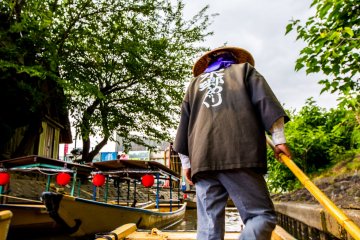It’s November, and autumn is truly here! The relentless heat of the Japanese summer has finally waned, and although the leaves haven’t donned their reds and yellows yet, it’s the best time of the year to go on a hike!
Since I don’t have a car, my hike that day actually began with a 25-minute walk from Azuchi Station to the site of the castle ruins. This walk was mostly flat, and took me past downtown Azuchi (a quiet countryside town), then through rice fields and vegetable patches. The sprawling view of the Japanese countryside was simply beautiful — the sky was high and clear, and with the view of the mountains, besides the cool autumn breeze, it was an easy and enjoyable walk.

At the site of the castle ruins, I was greeted with the sight of lush green grass and the stone walls of a former fortress. A lawn covers the front, and is maintained by a single, tiny robot mower (it really looks like a Roomba!). After climbing some steps to the entrance, and paying the entrance fee (700 yen for adults, 300 yen for high school students and younger), it was time to climb the stone steps up Mount Azuchi.


The original Azuchi Castle was built in 1576 by one of the three great heroes of Japan, Oda Nobunaga. Unlike most Japanese castles of the time, which were smaller in size and mostly strategic bases of defense situated atop mountains or hills, Azuchi Castle served as Nobunaga’s primary residence, and was also home to his wife and children. At the height of his powers, in 1582, he was inexplicably betrayed, attacked by his own military. Surrounded and injured, Nobunaga committed ritual suicide (seppuku) at Honno-ji Temple in Kyoto.
After the warlord’s death, his home, Azuchi Castle, was burned down. As his body was never found, his successor, Toyotomi Hideyoshi, later returned to the ruins of Azuchi Castle to bury Nobunaga’s belongings — his sword, his hitatare (traditional samurai kimono), and his eboshi (the ceremonial hat worn when a samurai attains manhood). This makes the mountain and its ruins the main mausoleum of Oda Nobunaga.
Today, all that’s left of the former grand castle are the Niomon Gate, a three-storied wooden pagoda known as the Sogenji Temple, and the foundation walls that once held up the castle, besides the many stone steps that lead you to the summit of Mount Azuchi. The mausoleum and shrine of Nobunaga still stands among the castle ruins, and a memorial service is held every year on June 2nd at the Sogenji Temple to mark the anniversary of the great hero’s death.
The middle section of stairs is by far the steepest and most difficult part of the hike. If it gets too much, you could always sit and rest for a little before continuing on! The entrance area also has walking sticks available for free use in helping visitors surmount the stairs. Azuchi Mountain’s summit can be reached in about 30~45 minutes. The foundation stones at the very top are where the former castle used to stand, with every smooth face of stone supporting a load-bearing wooden pillar.


The view of the sprawling Lake Biwa countryside can be seen through gaps in the tall trees. I sat down with some snacks (trail mix and beef jerky — hiking staples!), and was lucky to see red-tailed hawks up close, soaring through the warm air currents. Afterwards, I went to check out Sogenji Temple, and the views from that side of the mountain overlook Lake Sainoko, a small reservoir on the western shores of Biwa. From the outlook near Sogenji Temple, you can also see the Okutsu and Kasahoko mountain ranges that border the lake near Omihachiman.


On the route down from the summit, I descended through what felt like ancient forests, with tall pines and Japanese redwoods. The trail will take you down to the Niomon Gate, one of the only structures from the castle complex that still stands, wonderfully preserved to this day.


The second exit towards the main road was blocked off during my visit, so I followed a trail that looped back around towards the main entrance (without having to descend all those stairs from before, which was a win). Out by the exit, there were a couple of shops selling drinks and light snacks (kakigori, a shaved ice dessert that comes in an assortment of flavors, and mitarashi dango, glutinous rice balls in a sweet and savory soy-based sauce on a stick). There’s also a small gift shop with public restrooms, where you could even buy small souvenirs like hand towels and keychains.

All in all, my hike through history took not more than 1.5~2 hours. In pleasant weather, it was a wonderful little hike through beautiful redwoods, with a great view, that was off the beaten path. Highly recommended for the adventurous visitors or history buffs who happen to be passing through Shiga Prefecture!


















